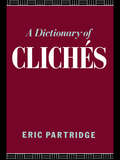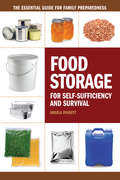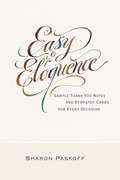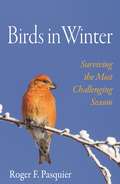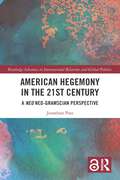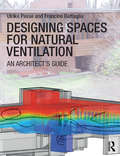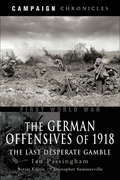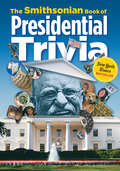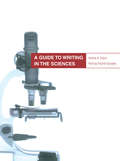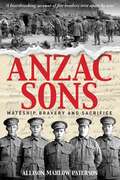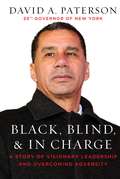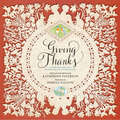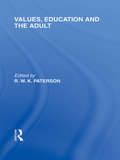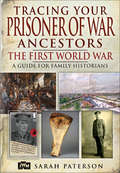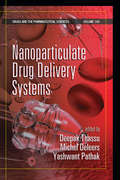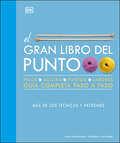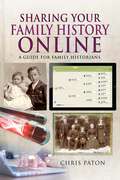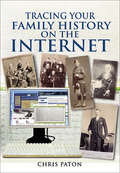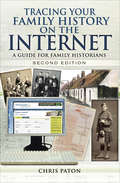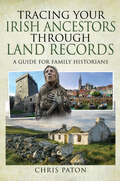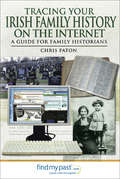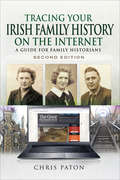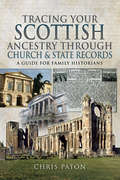- Table View
- List View
A Dictionary of Cliches
by Eric PartridgeThis work is full of things better left unsaid: hackneyed phrases, idioms battered into senselessness, infuriating Gallicisms, once-familiar quotations and tags from the ancient classics. It makes a formidable list, amplified as it is with definitions, sources, and indications of the clichés, venerability in every case.
Food Storage for Self-Sufficiency and Survival: The Essential Guide for Family Preparedness
by Angela PaskettBe Well Prepared and Well Fed! With all the uncertainty in the world today, there is peace in preparing. In an emergency, you don't want to depend on a grocery store or government agency to feed your family. Storing food assures your family's self-sufficiency year-round and benefits your budget when you plan correctly. This in-depth, nuts-and-bolts guide to storing food teaches you a variety of food storage methods that you can customize to meet your family's unique circumstances including family size, tastes, ages, health concerns, income, and living conditions. This is not a generic manual on stocking dehydrated meals that have ten-year shelf lives. It's the guide to storing foods your family loves so you can eat well no matter what challenges life throws at you. Inside you'll find: Food-storage options for 72-hour emergency kits, short-term emergencies and long-term survival. Food-storage planning methods that incorporate the foods and meals your family loves. Tips for how to maintain balance and variety in your food storage. Budget-friendly ways to purchase food for storage. Easy and practical ideas for cooking with food in storage so nothing expires or goes to waste. Organization and storage methods for easy food store maintenance. Water storage and purification methods. Canning, freezing and dehydrating methods to preserve food you produce at home. Storing food gives you the freedom to stretch your income in tight-budget months, pack quick meals for short-notice trips, and create healthy meals without constantly going to the grocery store. Plus your stored food is available if you do experience an emergency power outage, natural disaster, long-term illness or job loss. Let this guide help you start building your self-sufficiency and food storage today.
Easy Eloquence: Sample Thank You Notes and Sympathy Cards for Every Occasion
by Sharon PaskoffHave you ever wanted to thank someone for a gift or a kind act but didn't know what to say or how to say it?Easy Eloquencecan help. This collction of notes provides readers with the right words to help express their feelings. Complete with over 75 samples, this book makes it easy to write everything from thank you notes to sympathy cards.
Birds in Winter: Surviving the Most Challenging Season
by Roger F. PasquierHow birds have evolved and adapted to survive winterBirds in Winter is the first book devoted to the ecology and behavior of birds during this most challenging season. Birds remaining in regions with cold weather must cope with much shorter days to find food and shelter even as they need to avoid predators and stay warm through the long nights, while migrants to the tropics must fit into very different ecosystems and communities of resident birds. Roger Pasquier explores how winter affects birds’ lives all through the year, starting in late summer, when some begin caching food to retrieve months later and others form social groups lasting into the next spring. During winter some birds are already pairing up for the following breeding season, so health through the winter contributes to nesting success.Today, rapidly advancing technologies are enabling scientists to track individual birds through their daily and annual movements at home and across oceans and hemispheres, revealing new and unexpected information about their lives and interactions. But, as Birds in Winter shows, much is visible to any interested observer. Pasquier describes the season’s distinct conservation challenges for birds that winter where they have bred and for migrants to distant regions. Finally, global warming is altering the nature of winter itself. Whether birds that have evolved over millennia to survive this season can now adjust to a rapidly changing climate is a problem all people who enjoy watching them must consider.Filled with elegant line drawings by artist and illustrator Margaret La Farge, Birds in Winter describes how winter influences the lives of birds from the poles to the equator.
American Hegemony in the 21st Century: A Neo Neo-Gramscian Perspective (Routledge Advances in International Relations and Global Politics)
by Jonathan PassFor many years now debates over America hegemony and its supposed decline have circulated academic circles. The neo-Gramscians have greatly enriched our knowledge in this field, developing some key theoretical tools and concepts, yet ontological inconsistencies, notably the downgrading of structure, has meant their explanation of the dynamics of the contemporary world order remains somewhat incomplete. In this book, Jonathan Pass aims to counter such oversights, drawing directly on the ideas of Antonio Gramsci (amongst others) to elaborate a more sophisticated, overtly materialist, theory of world hegemony, rooted in a critical realist philosophy of science. Through the lens of this Neo neo-Gramscian (NNG) approach the book examines the complex interplay of internal and external social forces responsible for the evolving 'nature' of US hegemony, from its establishment in the 1940s, passing through its different stages of crisis and restructuring up to the present. China's spectacular rise undoubtedly constitutes a 'world event', but is it potentially a 'world hegemon'? The book seeks to sheds some light on this question, analysing the economic and geopolitical significance of China's emergence and how it affects, and is affected by, both American hegemony and its own extremely delicate 'passive revolution' at home. American Hegemony in the 21st Century presents a major contribution to International Relations, International, Political Economy, Politics and Philosophy and will be of interest to researchers looking for a more sophisticated and convincing analysis of the dynamics of the contemporary world order.
Designing Spaces for Natural Ventilation: An Architect's Guide
by Ulrike Passe Francine BattagliaBuildings can breathe naturally, without the use of mechanical systems, if you design the spaces properly. This accessible and thorough guide shows you how in more than 260 color diagrams and photographs illustrating case studies and CFD simulations. You can achieve truly natural ventilation, by considering the building's structure, envelope, energy use, and form, as well as giving the occupants thermal comfort and healthy indoor air. By using scientific and architectural visualization tools included here, you can develop ventilation strategies without an engineering background. Handy sections that summarize the science, explain rules of thumb, and detail the latest research in thermal and fluid dynamics will keep your designs sustainable, energy efficient, and up-to-date.
Research Methods: Concepts and Connections
by Michael PasserAt last, a fresh approach to the research methods course. With 20+ years experience teaching the course, Michael Passer knows what students understand and where they struggle. His highly anticipated new book, Research Methods: Concepts and Connections, offers students clear and compelling explanations and examples drawn from cutting-edge research from across the subfields of psychology. Readers come away with an unparalleled understanding of behavioral research practice in today’s world and how those skills apply to everyday life.
German Offensives of 1918: The Last Desperate Gamble (Campaign Chronicles)
by Ian PassinghamHe boldly reassesses German military doctrine, the strategic thinking behind the offensives and the effectiveness of the storm troop tactics used. He also considers how the poor state of German military morale and the privations and unrest of the German people contributed to the army's defeat.
The Smithsonian Book of Presidential Trivia
by Amy Pastan Smithsonian InstitutionWhich president holds the record for the most vetoes? Which president had the largest shoe size? Who was the only president to serve in both World War I and World War II? Who was the tallest president? These questions and many, many more are answered in The Smithsonian Book of Presidential Trivia.Divided into 11 chapters, The Smithsonian Book of Presidential Trivia looks at every aspect of our heads of state and presidential history: Citizens, Officers, Heroes, and Saviors; Stumping: From Front Porch to Facebook; The Pledge and the Parties; Inside the Oval Office; The Perpetual Podium; Home, Hotel, Parlor, Playground; First Families; Impeachment, Controversy, Shame; Assassination; Death, and National Mourning; Presidents in the Popular Imagination; and The Quotable President.Many of the questions are accompanied with photographs of artifacts from the Smithsonian's collections. The Smithsonian Book of Presidential Trivia is sure to puzzle the trivia buff and presidential expert alike!
A Guide to Writing in the Sciences
by Patricia Patchet-Golubev Andrea A. GilpinWhile teaching writing to undergraduate science students, Gilpin and Patchet-Golubev discovered that although many relatively sophisticated manuals for scientific writing exist, most are aimed at mainly professionals or specialists and are of little practical use to the majority of students. This introductory guide fills that large gap.Direct and friendly in tone the book provides clear and concise explanations of the basic elements of scientific writing required of students. The various genres are detailed -- in particular lab reports and research essays - as well as scientific articles, poster presentations, proposals, and even essay exams. Similarities and differences among these genres are underlined in order to illustrate structural principles and to provide practical writing tips. A detailed chapter covers the elements of grammar and punctuation that are fundamental to all good writing; it also outlines some key points about scientific style in particular.Using accessible language throughout, the authors organize their material with helpful lists, copious examples, and boxed writing and research tips. There are several useful appendices (including a classification chart of organisms and an international units conversion chart), an index, and selected bibliography on science and technical writing. Unique in its field, this guide offers a practical and valuable guide to the basic principles and conventions of science writing.
Anzac Sons: Mateship, Bravery and Sacrifice
by Allison Paterson…Well dear Jim it breaks my heart to write this letter. Our dear [brother] was killed yesterday morning at 5.30. The bullet killed him instantly and he never spoke a word. I had just left him and gone down the trench to see the other lads when I was called back. Oh Jim it is awful … Oh I do hope he is the last … It is April 27, 1918, Jim&’s brother writes from the battlefields of France. Of five brothers serving on the Western Front, three have given their lives; another has been hospitalized. Six agonizing months of brutal warfare were yet to be endured … World War I was a senseless tragedy. Its long shadow darkened the four corners of the world. In Mologa, Victoria, once a bustling community, stands a lonely stone memorial. Etched within the granite are the names of the Marlow brothers and their mates; a testament to ordinary people who became heroes. Anzac Sons is composed from a collection of over 500 letters and postcards written by the brothers who served. From the training grounds of Victoria, Egypt and England, to the Western Front battlefields – Pozieres, Bullecourt, Messines, Menin Road, Passchendaele, Villers-Bretonneux and the battles of 1918 – this compelling true story was compiled by the granddaughter of a surviving brother. She takes us on her journey as she walks in the footsteps of her ancestors.This is a story of mateship, bravery and sacrifice; it is a heartbreaking account of a family torn apart by war. It is a pledge to never forget.
Black, Blind, & In Charge: A Story of Visionary Leadership and Overcoming Adversity
by David Paterson"I have had this desire my whole life to prove people wrong, to show them I could do things they didn't think I could do.&”--David PatersonA title that hits you between the eyes is second only to a Governor put in office by a prostitution scandal. Scandals aside, David Paterson overcame severe disability and racial prejudice to become a state senator, lieutenant governor, and—unexpectedly—governor of New York.Paterson is well known for his remarkable vision. In a rising climate of denial and with fiscal crisis looming, Paterson appeared—seemingly from the wilderness—to sound the alarm about the impending crisis after being in service for only a few months. But his leadership extends well beyond reducing a 21.3-billion-dollar budget deficit during the worst economic downturn in recent history. From standing in protest outside Amazon against Kindle accessibility for the blind, to advocating the overthrow of a corrupt Trinidadian government, he made his mark during his three-year tenure. He made procedural changes that resulted in no state budget being late since his departure from office. He fought for same sex marriage and against disability discrimination. When he appeared on an episode of Saturday Night Live, he even quipped, &“You guys spent so much time talking about my blindness that I forgot I was black.&”Paterson was the first and only blind governor—other than a man who held the title for eleven days in 1975—and the fourth person of African descent to hold the office of governor in American history. Paterson may also be the only governor in history to have been arrested outside the governor's office prior to his service. You will want to read about that one.His candid admissions, even while serving as governor, are refreshing in this era where the truth and public servants are rarely mentioned in the same sentence.This book is at times hilarious, shocking, heartfelt, and then—when you least expect it—soulful, passionate, irreverent, and extraordinary. This is a self-help book encapsulated from the memories of one who continues to help himself through his service to others, the credo of public life.Since leaving office, the former governor has flourished as a talk show host, consultant to industry, Chair of the NY State Democratic Party, Director of Investments with the Moldaver Paterson Lee Group at Stifel Investment Bank, and now Senior Vice President & Special Advisor to the President of the Las Vegas Sands Corporation.What&’s next for David Paterson? The governor stated in one of his lighter moments in the journey of Black, Blind and In Charge: &“I may take a run at the Presidency, or, better still, the Vice Presidency and another scandal.&”
Giving Thanks: Poems, Prayers, and Praise Songs of Thanksgiving
by Katherine Paterson Pamela DaltonNewbery Medal winner Katherine Paterson and cut-paper artist Pamela Dalton give fans of all ages even more to be thankful for with Giving Thanks, a special book about gratitude. Katherine Paterson's meditations on what it means to be truly grateful and Pamela Dalton's exquisite cut-paper illustrations are paired with a collection of over 50 graces, poems, and praise songs from a wide range of cultures, religions, and voices. The unique collaboration between these two extraordinary artists flowers in this important and stunningly beautiful reflection on the act of giving thanks.
Values, Education and the Adult (International Library of the Philosophy of Education Volume 16)
by R.W.K. PatersonIn this study of the main conceptual and normative issues to which the education of the adult gives rise, the author demonstrates that these issues can be understood and resolved only by coming to grips with some of the central and most contentious questions in epistemology, philosophy of mind, ethics, and social philosophy. A salient feature of the book is its searching examination of the different types of value judgement by which all educational discourse is permeated. The analysis of the nature and justification of educational judgements forms the basis of an overall philosophy of adult education which should provide a much needed axiological framework for the guidance of practitioners in this growing area of educational concern.
Tracing Your Prisoner of War Ancestors: The First World War (Tracing Your Ancestors)
by Sarah PatersonThe experience of civilian internees and British prisoners of war in German and Turkish hands during the First World War is one of the least well-known and least researched aspects of the history of the conflict. The same applies to prisoners of war and internees held in the UK. Yet, as Sarah Paterson shows in this authoritative handbook, a wide-range of detailed and revealing information is available if you know where to look for it.Briefly she outlines the course of the campaigns in which British servicemen were captured, and she describes how they were treated and the conditions they endured. She locates the camps they were taken to and explains how they were run. She also shows how this emotive and neglected subject can be researched - how archives and records can be used to track down individual prisoners and uncover something of the lives they led in captivity.Her work will be an essential introduction for readers who are keen to get an insight into the experience of a POW or an internee during the First World War, and it will be an invaluable guide for anyone who is trying to trace an ancestor who was captured.
Nanoparticulate Drug Delivery Systems: Barriers And Application Of Nanoparticulate Systems (Drugs And The Pharmaceutical Sciences Ser. #Vol. 166)
by Yashwant Vishnupant Pathak Deepak Thassu Michel DeleersWith the advent of analytical techniques and capabilities to measure particle sizes in nanometer ranges, there has been tremendous interest in the use of nanoparticles for more efficient methods of drug delivery. Nanoparticulate Drug Delivery Systems addresses the scientific methodologies, formulation, processing, applications, recent trends, and e
El gran libro del punto (The Knitting Book)
by Frederica PatmoreEsta nueva edición de 'El gran libro del punto' te lleva de principiante a experto, con cientos de técnicas paso a paso, más de 120 patrones para una variedad de tipos de punto y 20 proyectos de tejido adecuados para todas las habilidades.Totalmente ilustrado y fácil de usar, 'El gran libro del punto' es un recurso único para principiantes y una rica fuente de inspiración para ávidos costureros que quieran progresar y probar nuevos patrones. Cada técnica se muestra con claras fotografías paso a paso y se explica con anotaciones y flechas, desde la puntada básica hasta los patrones más intrincados.Una galería fotográfica muestra más de 120 puntadas diferentes para inspirar al lector: pruebe todo y personalice proyectos con sus propias opciones de puntadas.Esta edición actualizada presenta 10 patrones de proyectos nuevos, incluido un patrón de tejido de brazo, así como 10 proyectos de la edición original que se han reinventado con nuevos hilos y colores frescos.Simple, claro e integral, 'El gran libro del punto' es el único libro que necesita para mejorar sus habilidades y crear sus propias piezas hermosas y únicas."This new edition of 'El gran libro del punto' takes you from beginner to expert, with hundreds of step-by-step techniques, more than 120 stitch patterns for a variety of knitting stitches, and 20 knitting projects suitable for all abilities.Fully illustrated and easy to use, 'El gran libro del punto' is a one-stop resource for beginners and a rich source of inspiration for avid knitters who want to progress their skills and try new stitch patterns. Each technique is shown in clear photographic steps and explained with helpful annotations and arrows, from basic casting on to intricate Fair Isle and cable patterns.A photographic stitch gallery showcases over 120 different stitches to inspire you - try your hand at everything from garter stitch to intarsia, or customize projects with your own stitch choices.This updated edition features 10 brand-new project patterns, including an arm knitting pattern, as well as 10 projects from the original edition that have been reimagined with new yarns and fresh colours.Simple, clear, and comprehensive, 'El gran libro del punto' is the only book you need to progress your skills and create your own beautiful, unique pieces."
Sharing Your Family History Online: A Guide for Family Historians (Tracing Your Ancestors)
by Chris PatonAn expert genealogist explains how to share your family history online and collaborate with distant relatives to build a richer ancestral story.For many enthusiasts pursuing their family history research, the online world offers a seemingly endless archive of digitized materials. In addition to hosting records, however, the internet also offers a unique platform on which we can host our research and potentially connect with distant relatives from around the world.In Sharing Your Family History Online, genealogist Chris Paton demonstrates the many ways we can present our research and encourage collaboration online. He details helpful organizations and social media applications, describes the software platforms on which we can collate our stories, and illustrates the variety of ways we can publish our stories online.Along the way, Paton also explores how we can make our research work for us, by connecting with experts and relatives who can help solve ancestral mysteries. This happens not only by sharing stories, but by accessing uniquely held documentation by family members around the world, including our shared DNA.
Tracing Your Family History on the Internet: A Guide For Family Historians (Tracing Your Ancestors)
by Chris PatonA genealogist&’s practical guide to researching family history online while avoiding inaccurate, incomplete, or misleading information. The internet has revolutionized family history research—every day new records and resources are placed online and new methods of sharing research and communicating become available. Never before has it been so easy to research family history and to gain a better understanding of who we are and where we came from. But, as British genealogist Chris Paton demonstrates in this straightforward, practical guide, while the internet is an enormous asset, it is also something to be wary of. Researchers need to take a cautious approach to the information they acquire on the web. Where did the original material come from? Has it been accurately reproduced? Why was it put online? What has been left out and what is still to come? As he leads researchers through the multitude of resources that are now accessible online with an emphasis on UK and Ireland sites, Chris Paton helps to answer these questions. He shows what the internet can and cannot do—and he warns against the various traps researchers can fall into along the way.
Tracing Your Family History on the Internet, Second Edition: A Guide for Family Historians (Tracing Your Ancestors Ser.)
by Chris PatonThis fully revised second edition of Chris Paton's best-selling guide is essential reading if you want to make effective use of the internet in your family history research. Every day new records and resources are placed online and new methods of sharing research and communicating across cyberspace become available, and his handbook is the perfect introduction to them. He has checked and updated all the links and other sources, added new ones, written a new introduction and substantially expanded the social networking section. Never before has it been so easy to research family history using the internet, but he demonstrates that researchers need to take a cautious approach to the information they gain from it. They need to ask, where did the original material come from and has it been accurately reproduced, why was it put online, what has been left out and what is still to come? As he leads the researcher through the multitude of resources that are now accessible online, he helps to answer these questions. He shows what the internet can and cannot do, and he warns against the various traps researchers can fall into along the way.As seen in Your Family Tree Magazine.
Tracing Your Irish Ancestors Through Land Records: A Guide for Family Historians (Tracing Your Ancestors)
by Chris PatonThe history of Ireland is one that was long dominated by the question of land ownership, with complex and often distressing tales over the centuries of dispossession and colonization, religious tensions, absentee landlordism, subsistence farming, and considerably more to sadden the heart. Yet with the destruction of much of Ireland's historic record during the Irish Civil War, and with the discriminatory Penal Laws in place in earlier times, it is often within land records that we can find evidence of our ancestors' existence, in some cases the only evidence, where the relevant vital records for an area may never have been kept or may not have survived. In Tracing Your Irish Ancestors Through Land Records, genealogist and best-selling author Chris Paton explores how the surviving records can help with our ancestral research, but also tell the stories of the communities from within which our ancestors emerged. He explores the often controversial history of ownership of land across the island, the rights granted to those who held estates and the plights of the dispossessed, and identifies the various surviving records which can help to tease out the stories of many of Ireland's forgotten generations. Along the way Chris Paton identifies the various ways to access the records, whether in Ireland's many archives, local and national, and increasingly through a variety of online platforms.
Tracing Your Irish Family History on the Internet: A Guide for Family Historians (Tracing Your Ancestors)
by Chris Paton&“A thorough and informative guide . . . with as many references to websites for Northern Irish genealogy as for the Republic of Ireland.&” —Who Do You Think You Are Magazine Ireland has experienced considerably more tragedy when it comes to the preservation of resources for family historians than its close neighbor Britain. Many of the nation&’s primary records were lost during the civil war in 1922 and through other equally tragic means. But in this new book Chris Paton, the Northern-Irish-born author of the bestselling Tracing Your Family History on the Internet, shows that not only has a great deal of information survived, it is also increasingly being made available online. Thanks to the pioneering efforts of the Public Record Office of Northern Ireland, the National Archives of Ireland, organizations such as FindmyPast Ireland, Ancestry.co.uk and RootsIreland, and the massive volunteer genealogical community, more and more of Ireland&’s historical resources are accessible from afar. As well as exploring the various categories of records that the family historian can turn to, Chris Paton illustrates their use with fascinating case studies. He fully explores the online records available from both the north and the south from the earliest times to the present day. Many overseas collections are also included, and he looks at social networking in an Irish context where many exciting projects are currently underway. His book is an essential introduction and source of reference for anyone who is keen to trace their Irish roots.&“Chris Paton has produced this much-needed book for researchers tracing Irish roots, pulling together all the current online resources and expert advice into one handy guide.&” —Family Tree Magazine
Tracing Your Irish Family History on the Internet, Second Edition: A Guide for Family Historians (Tracing Your Ancestors)
by Chris PatonA simple, easy-to-use guide to tracing your Irish ancestry via the Internet. In this, the fully updated second edition of his best-selling guide to researching Irish history using the Internet, Chris Paton shows the extraordinary variety of sources that can now be accessed online. Although Ireland has lost many records that would have been of great interest to family historians, he demonstrates that a great deal of information survived and is now easily available to the researcher. Thanks to the pioneering efforts of the Public Record Office of Northern Ireland, the National Archives of Ireland, organizations such as FindmyPast Ireland, Ancestry.co.uk, and RootsIreland and the volunteer genealogical community, an ever-increasing range of Ireland&’s historical resources are accessible from afar. As well as exploring the various categories of records that the family historian can turn to, Chris Paton illustrates their use with fascinating case studies. He fully explores the online records available from both the north and the south from the earliest times to the present day. Many overseas collections are also included, and he looks at social networking in an Irish context where many exciting projects are currently underway. Paton&’s book is an essential introduction and reference for anyone who is keen to trace their Irish roots.
Tracing Your Scottish Ancestry through Church and State Records: A Guide for Family Historians (A\guide For Family Historians Ser.)
by Chris Paton&“The ideal instructional guide and reference for anyone doing genealogical research&” by the author of Tracing Your Scottish Family History on the Internet (Midwest Book Review). Despite its Union with England and Wales in 1707, Scotland remained virtually independent from its partners in many ways, retaining its own legal system, its own state church, and its own education system. In Tracing Scottish Ancestry Through Church and State Records, genealogist Chris Paton examines the most common records used by family historians in Scotland, ranging from the vital records kept by the state and the various churches, the decennial censuses, tax records, registers of land ownership and inheritance, and records of law and order. Through precepts of clare constat and ultimus haeres records, feudalism and udal tenure, to irregular marriages, penny weddings and records of sequestration, Chris Paton expertly explores the unique concepts and language within many Scottish records that are simply not found elsewhere within the British Isles. He details their purpose and the information recorded, the legal basis by which they were created, and where to find them both online and within Scotland&’s many archives and institutions. &“A useful and very readable introduction to Scottish records, with many case studies to assist the reader, but there is also much in it that may be new to more experienced family historians.&” —The Local Historian, journal of the British Association for Local History &“Leads the reader through the Scottish record jungle.&” —Canada&’s Anglo-Celtic Connections
Tracing Your Scottish Ancestry through Church and State Records: A Guide for Family Historians (A\guide For Family Historians Ser.)
by Chris Paton&“The ideal instructional guide and reference for anyone doing genealogical research&” by the author of Tracing Your Scottish Family History on the Internet (Midwest Book Review). Despite its Union with England and Wales in 1707, Scotland remained virtually independent from its partners in many ways, retaining its own legal system, its own state church, and its own education system. In Tracing Scottish Ancestry Through Church and State Records, genealogist Chris Paton examines the most common records used by family historians in Scotland, ranging from the vital records kept by the state and the various churches, the decennial censuses, tax records, registers of land ownership and inheritance, and records of law and order. Through precepts of clare constat and ultimus haeres records, feudalism and udal tenure, to irregular marriages, penny weddings and records of sequestration, Chris Paton expertly explores the unique concepts and language within many Scottish records that are simply not found elsewhere within the British Isles. He details their purpose and the information recorded, the legal basis by which they were created, and where to find them both online and within Scotland&’s many archives and institutions. &“A useful and very readable introduction to Scottish records, with many case studies to assist the reader, but there is also much in it that may be new to more experienced family historians.&” —The Local Historian, journal of the British Association for Local History &“Leads the reader through the Scottish record jungle.&” —Canada&’s Anglo-Celtic Connections
